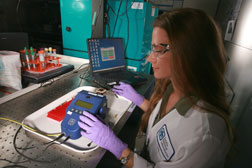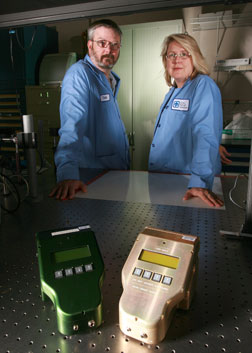NEWS RELEASES
FOR IMMEDIATE RELEASE | Broadcast-quality video available.
November 28, 2006
Sandia research to focus on early detection of harmful algal blooms (HABs)
 Sandia researcher Amanda Jokerst injects a sample into a handheld microseparations platform for analysis. Jokerst and others at Sandia aim to optimize the micro-separations process for a sub-set of relevant toxins found in harmful algal blooms (HABs) and establish the laboratory-based protocols for sample preparation.
Sandia researcher Amanda Jokerst injects a sample into a handheld microseparations platform for analysis. Jokerst and others at Sandia aim to optimize the micro-separations process for a sub-set of relevant toxins found in harmful algal blooms (HABs) and establish the laboratory-based protocols for sample preparation.Download 300dpi JPEG image, “mandy-jokerst.jpg,” 496K (Media are welcome to download/publish this image with related news stories.)
LIVERMORE, Calif. — Sandia National Laboratories researchers Todd Lane and Victoria VanderNoot have been awarded a research grant to develop a technology that can successfully detect deadly toxins from harmful algal blooms (HABs). The funding is provided by the Cooperative Institute for Coastal and Estuarine Environmental Technology (CICEET), a partnership of the National Oceanic and Atmospheric Administration (NOAA) and the University of New Hampshire.
Lane and VanderNoot, a molecular biologist and an analytical chemist, respectively, are both in the Biosystems Research department at Sandia’s Livermore, Calif., site. In addressing the HAB problem, they will employ laser-induced fluorescence and other separation methods inherent in Sandia’s µChemLab™ (“Micro” ChemLab) technology. Along with a small team of Sandia colleagues and external collaborators, they have commenced with the research, which could lead to longer-term funding after the initial “proof of principle” work has been completed.
Sandia is a National Nuclear Security Administration laboratory.
HABs: devastating for coastal ecology and fisheries
Harmful algal blooms are widely acknowledged to be a severe coastal resource management issue, adversely impacting virtually every coastal region. Current methods for detecting the poisonous toxins characteristic of the blooms are cumbersome, require either expensive reagents or animal testing, or are unable to quantify toxins — critical information for managing shellfish beds. The technologies under development at Sandia would eliminate these problems.
 Sandia researchers Todd Lane (left) and Victoria VanderNoot
(right) are leading an effort, funded by the National Oceanic
and Atmospheric Administration (NOAA) and the University of New
Hampshire, to detect deadly toxins from HABs. The project employs
laser-induced fluorescence and other separation methods inherent
in Sandia’s µChemLab™ device, examples of which are seen
here.
Sandia researchers Todd Lane (left) and Victoria VanderNoot
(right) are leading an effort, funded by the National Oceanic
and Atmospheric Administration (NOAA) and the University of New
Hampshire, to detect deadly toxins from HABs. The project employs
laser-induced fluorescence and other separation methods inherent
in Sandia’s µChemLab™ device, examples of which are seen
here.Download 300dpi JPEG image, “algal-lab.jpg,” 496K (Media are welcome to download/publish this image with related news stories.)
“Today’s standard detection methods, frankly, are too slow and labor-intensive,” said Lane. “By the time the process is complete, it’s too late: the shellfish beds are already toxic.” The ability to quickly sample organisms low on the food chain, Lane said, can provide an early warning system to help protect communities from exposure to toxins.
Most species of algae are not harmful and actually serve as the energy producers at the depths of the food web. The dense patches (or “blooms”) that sometimes accumulate near the surface of the water, however, can produce potent neurotoxins that are then transferred through the food chain, accumulating in zooplankton and shellfish, eventually harming or even killing marine mammals and humans that consume tainted shellfish.
Sandia to focus on early-warning detection methods
The Sandia research will focus on enhancing the early-warning capability of detection and is expected to lay the groundwork for the development of a reliable, cost-effective prototype to simultaneously analyze multiple HAB toxins in phytoplankton and/or shellfish in the field. Lane and his colleagues will aim to optimize the micro-separations process for a sub-set of relevant toxins, and establish the laboratory-based protocols for sample preparation.
The long-term goal, should the initial phase of the Sandia research go as planned, is to develop small, lightweight devices that could be fielded by oceanographers and marine biologists as part of their regular monitoring systems.
In addition to Sandia’s Lane and VanderNoot, collaborators include Donald M. Anderson, a senior scientist and director of the Coastal Ocean Institute, Woods Hole Oceanographic Institute; and Gregg Langlois, marine biologist at the California Department of Health Services.
The technologies developed under this effort will be equally well suited to detecting algal toxins in freshwater sources and complements other ongoing research at Sandia. Sandia’s Water Initiative (www.sandia.gov/water), for example, strives to increase the safety, security and sustainability of water infrastructure through the development of advanced technologies that create new water supplies, decrease demand through water-use efficiency, and provide decision-informing tools to the institutions responsible for balancing supply and demand.
Sandia is a multiprogram laboratory operated by Sandia Corporation, a Lockheed Martin company, for the U.S. Department of Energy’s National Nuclear Security Administration. Sandia has major R&D responsibilities in national security, energy and environmental technologies, and economic competitiveness.
Sandia news media contact: Mike Janes, mejanes@sandia.gov, (925) 294-2447